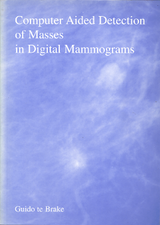Computer Aided Detection of Masses in Digital Mammograms
G. te Brake
- Promotor: C. Gielen
- Copromotor: N. Karssemeijer
- Graduation year: 2000
- Radboud University, Nijmegen
Abstract
This thesis describes the components of an automated detection method for masses and architectural distortions, signs of infiltrating cancer. Masses and architectural distortions can be very subtle and are frequently missed by radiologists. Because the success of treatment of breast cancer depends largely on the stage of the tumor at the time of detection, early detection is very important. Masses have two main image characteristics that can be used for detection: a radiating pattern of spicules and a mass. Sometimes both characteristics are present, but often only spicules or just a faint mass is visible. To achieve high sensitivity on the whole spectrum of possible appearances of masses and distortions, detection of both characteristics is essential. Chapter 2 describes a sensitive method to detect radiating spicule patterns using statistical analysis of line orientations. However, many masses do not show clear spiculation, and must be detected by their mass. Chapter 3 describes how the spicule detection method can be transformed to a mass detection method. Instead of a map of line orientations, a map of gradient orientations is computed. Statistical analysis of this orientation map was used to detect masses. A large set of mammograms taken from the Nijmegen screening program was used to test a detection method based on spicules, a detection method based on masses, and a detection method that detects both spicules and masses. Best results were obtained when both the spiculation and mass features were used. Of all masses, 85% was detected at a specificity level of 1 false positive per image, 55% at 1 false positive per 10 images. The diameter of masses in mammograms varies from 5 mm to 5 cm, inspiring many research groups to use multi-scale approaches to detect masses. However, the benefit of applying their method in a multi-scale way is almost never compared to a single-scale version of their method. In Chapter 4, the mass detection method of Chapter 3 and two popular pattern recognition techniques to detect bright areas were applied in a single and multi-scale way to examine the possible gain of multi-scale detection. It appeared that the multi-scale versions of the mass detection method had similar performance as a single-scale approach if this scale was chosen appropriately. Of course, when the scale for the single-scale approach was chosen sub-optimally the performance was lower. This study shows that it is not self-evident that a multi-scale mass detection method gives better results than a single-scale version of the method. A multi-scale method is sensitive for masses over a range of sizes, but is also sensitive for false positives of different sizes. The specificity level that was achieved by the mass detection method described in Chapter 3 is not high enough for successful application in the clinic or in screening. To improve the specificity, a second stage was designed, that classifies each detected region based on regional criteria like contrast, shape, and texture. Based on such features, many normal tissue regions could be discriminated from real masses. To compute these features, a segmentation of the suspicious regions is required. In Chapter 5, a method is described to segment masses 126 using a discrete dynamic contour model. For each region a size estimate was available of the suspect region, and an appropriate initial starting contour was created that was fitted to the edge of the region. The method proved to be fast and robust, and outperformed a region growing approach. In Chapter 6, the contour model was used to segment regions that were found by the mass detection method of Chapter 3. A number of features were implemented that capture image characteristics that radiologists use to determine whether a suspicious region is a mass or dense normal tissue. Classification using these regional features gave a large reduction in false positives at each desired sensitivity level. On two large datasets a relatively high sensitivity was achieved even at high specificity levels. In Chapter 7
